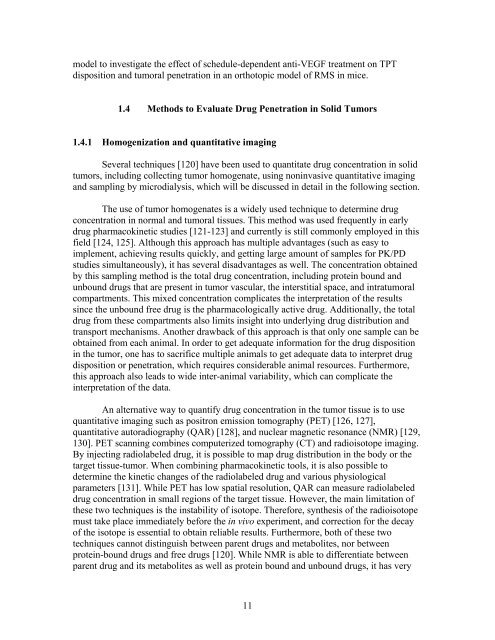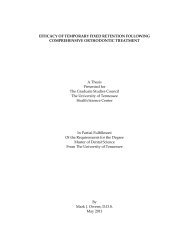BEVACIZUMAB EFFECT ON TOPOTECAN PHARMACOKINETICS ...
BEVACIZUMAB EFFECT ON TOPOTECAN PHARMACOKINETICS ...
BEVACIZUMAB EFFECT ON TOPOTECAN PHARMACOKINETICS ...
Create successful ePaper yourself
Turn your PDF publications into a flip-book with our unique Google optimized e-Paper software.
model to investigate the effect of schedule-dependent anti-VEGF treatment on TPT<br />
disposition and tumoral penetration in an orthotopic model of RMS in mice.<br />
1.4 Methods to Evaluate Drug Penetration in Solid Tumors<br />
1.4.1 Homogenization and quantitative imaging<br />
Several techniques [120] have been used to quantitate drug concentration in solid<br />
tumors, including collecting tumor homogenate, using noninvasive quantitative imaging<br />
and sampling by microdialysis, which will be discussed in detail in the following section.<br />
The use of tumor homogenates is a widely used technique to determine drug<br />
concentration in normal and tumoral tissues. This method was used frequently in early<br />
drug pharmacokinetic studies [121-123] and currently is still commonly employed in this<br />
field [124, 125]. Although this approach has multiple advantages (such as easy to<br />
implement, achieving results quickly, and getting large amount of samples for PK/PD<br />
studies simultaneously), it has several disadvantages as well. The concentration obtained<br />
by this sampling method is the total drug concentration, including protein bound and<br />
unbound drugs that are present in tumor vascular, the interstitial space, and intratumoral<br />
compartments. This mixed concentration complicates the interpretation of the results<br />
since the unbound free drug is the pharmacologically active drug. Additionally, the total<br />
drug from these compartments also limits insight into underlying drug distribution and<br />
transport mechanisms. Another drawback of this approach is that only one sample can be<br />
obtained from each animal. In order to get adequate information for the drug disposition<br />
in the tumor, one has to sacrifice multiple animals to get adequate data to interpret drug<br />
disposition or penetration, which requires considerable animal resources. Furthermore,<br />
this approach also leads to wide inter-animal variability, which can complicate the<br />
interpretation of the data.<br />
An alternative way to quantify drug concentration in the tumor tissue is to use<br />
quantitative imaging such as positron emission tomography (PET) [126, 127],<br />
quantitative autoradiography (QAR) [128], and nuclear magnetic resonance (NMR) [129,<br />
130]. PET scanning combines computerized tomography (CT) and radioisotope imaging.<br />
By injecting radiolabeled drug, it is possible to map drug distribution in the body or the<br />
target tissue-tumor. When combining pharmacokinetic tools, it is also possible to<br />
determine the kinetic changes of the radiolabeled drug and various physiological<br />
parameters [131]. While PET has low spatial resolution, QAR can measure radiolabeled<br />
drug concentration in small regions of the target tissue. However, the main limitation of<br />
these two techniques is the instability of isotope. Therefore, synthesis of the radioisotope<br />
must take place immediately before the in vivo experiment, and correction for the decay<br />
of the isotope is essential to obtain reliable results. Furthermore, both of these two<br />
techniques cannot distinguish between parent drugs and metabolites, nor between<br />
protein-bound drugs and free drugs [120]. While NMR is able to differentiate between<br />
parent drug and its metabolites as well as protein bound and unbound drugs, it has very<br />
11
















